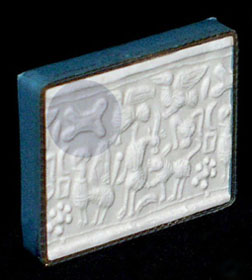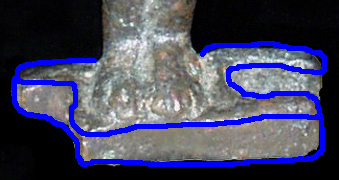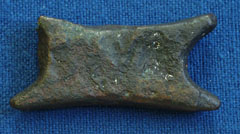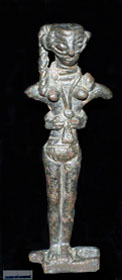| Visiting | Features | The Collections |
Services | Online Resources |
More Resources |
SiteMap |
 |
Ashmolean Museum of Art and Archaeology |
|
|
| AMULETs | |||
| Ancient
Cyprus in the Ashmolean Museum |
| Cypriot Copper: Mysteries of the Bronze Age | |||
|
The Copper Trade: Ingots, Hoards and Ship Wrecks
|
|||
This 15th century BC cylinder seal from Pyla (right) shows a fanciful scene which includes the depiction of a stylized oxhide ingot. Some scholars feel that this early representation of an oxhide ingot is evidence that that oxhide ingots were known to Cypriotes as early as the 15th Century BC. Besides the ingot, this seal shows birds, a griffin, a dagger, an ibex being attacked by a lion and a bucranium (a sculpture representing an ox skull adorned with wreaths). It could be argued that the oxhide ingot, in association with the mythical world represented by the griffin, might have been ascribed a sort of symbolic status. There is no way to prove this, but the form of the oxhide ingot is also represented in association with a possible goddess figure. |
 Cylinder Seal (right) with plaster impression (left) showing depictions of an oxhide ingot, birds, a griffin and an ibex being attacked by a lion (AN1896.5) |
||
 Ingot shape highlighted |
|||
|
|
This bronze figurine is standing on an oxhide ingot (left, AN1971.888). It has been suggested that this female statuette may have been worshipped as a sort of fertility goddess, and linked with the oxhide ingot to ensure the continuation of a plentiful supply of copper (Catling 1969). All deities of this kind have been dated to the Late Bronze Age (Dalley 1987). |

Close up of base of figurine; 3 ears of the ingot are visible, the fourth has broken off. |
|
| Previous
Page (Copper in Bronze Age Cyprus) |
Introduction
to the Mysteries of the Bronze Age |
Next
Page (The Copper Trade continued) |
|
| Ancient Cyprus in the Ashmolean |
© Copyright University of Oxford, Ashmolean Museum, 2004 The Ashmolean Museum retains the copyright of all materials used here and in its Museum Web pages. Last updated: 21-oct-2004 |
|
HomePage | Visiting
| Features
| The Collections Services | Online Resources | More Resources | SiteMap | Top of Page |
 The
ingots are referred to as 'oxhide' because their shape resembles a dried
oxhide, with peaks in the four corners. This mini Oxhide ingot from
Makarsta (Croatia,
The
ingots are referred to as 'oxhide' because their shape resembles a dried
oxhide, with peaks in the four corners. This mini Oxhide ingot from
Makarsta (Croatia, 